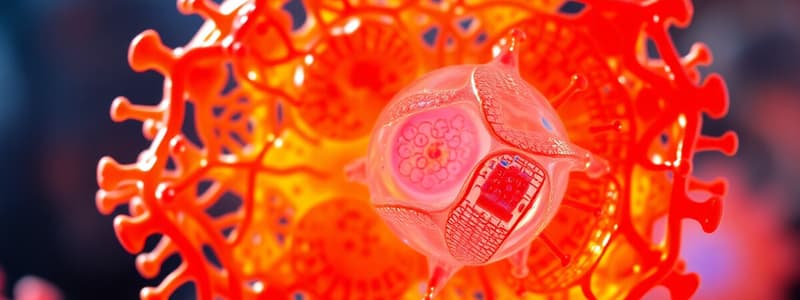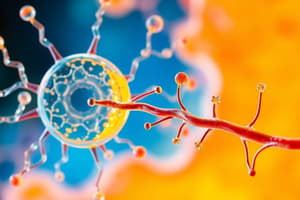Podcast
Questions and Answers
What is the primary function of ribosomes in a cell?
What is the primary function of ribosomes in a cell?
- Packaging cellular products
- Detoxifying hydrogen peroxide
- Storing DNA
- Making proteins (correct)
Which process generates the majority of ATP within a cell?
Which process generates the majority of ATP within a cell?
- Oxidative Phosphorylation (correct)
- Glycolysis
- Krebs Cycle
- Fermentation
Where does glycolysis occur within the cell?
Where does glycolysis occur within the cell?
- Rough endoplasmic reticulum
- Mitochondria
- Cytoplasm (correct)
- Nucleus
What is the role of oxygen in the electron transport chain?
What is the role of oxygen in the electron transport chain?
Which organelle is primarily responsible for producing ATP?
Which organelle is primarily responsible for producing ATP?
What is produced during the Krebs Cycle?
What is produced during the Krebs Cycle?
What structure in the cell membrane enables it to function effectively?
What structure in the cell membrane enables it to function effectively?
Which component does not contain ribosomes?
Which component does not contain ribosomes?
Which stage of cellular respiration does not require oxygen?
Which stage of cellular respiration does not require oxygen?
What is the main function of the Golgi Apparatus?
What is the main function of the Golgi Apparatus?
What type of bond forms between amino acids to create proteins?
What type of bond forms between amino acids to create proteins?
Which level of protein structure involves the sequence of amino acids?
Which level of protein structure involves the sequence of amino acids?
What happens to the complexity of a protein's structure during denaturation?
What happens to the complexity of a protein's structure during denaturation?
Which of the following describes the role of enzymes?
Which of the following describes the role of enzymes?
What is the structure of triglycerides composed of?
What is the structure of triglycerides composed of?
Which of the following is an isomer of glucose?
Which of the following is an isomer of glucose?
What occurs during a neutralization reaction?
What occurs during a neutralization reaction?
Which type of acid-base interaction involves proton donors?
Which type of acid-base interaction involves proton donors?
What is created when glucose and fructose combine?
What is created when glucose and fructose combine?
What structural features are characteristic of lipid molecules?
What structural features are characteristic of lipid molecules?
Which statement about osmosis is correct?
Which statement about osmosis is correct?
What distinguishes active transport from passive transport?
What distinguishes active transport from passive transport?
What is the main function of RNA polymerase?
What is the main function of RNA polymerase?
How are homozygous and heterozygous genotypes defined?
How are homozygous and heterozygous genotypes defined?
Which of the following best describes a covalent bond?
Which of the following best describes a covalent bond?
What happens during mitosis?
What happens during mitosis?
What is true about isotopes?
What is true about isotopes?
Which description of the periodic table is correct?
Which description of the periodic table is correct?
What characteristic is common to all macronutrients?
What characteristic is common to all macronutrients?
In translation, what role do ribosomes play?
In translation, what role do ribosomes play?
What is the process where ATP is generated called?
What is the process where ATP is generated called?
If you put cell into hypertonic/hyperosmotic/concentrated solution, water rushes out and the cell
If you put cell into hypertonic/hyperosmotic/concentrated solution, water rushes out and the cell
If you put cell into hypotonic/hypoosmotic/dilute solution, water rushed in and the cell
If you put cell into hypotonic/hypoosmotic/dilute solution, water rushed in and the cell
What happens in the basic process?
What happens in the basic process?
Flashcards
Hypothesis
Hypothesis
A testable explanation for an observation, formed from observations
Cell Membrane
Cell Membrane
A phospholipid bilayer that surrounds a cell
Ribosomes
Ribosomes
Protein factories that synthesize proteins
Smooth ER
Smooth ER
Signup and view all the flashcards
Nucleus
Nucleus
Signup and view all the flashcards
Mitochondria
Mitochondria
Signup and view all the flashcards
Golgi Apparatus
Golgi Apparatus
Signup and view all the flashcards
Peroxisomes
Peroxisomes
Signup and view all the flashcards
Cellular Respiration
Cellular Respiration
Signup and view all the flashcards
Glycolysis
Glycolysis
Signup and view all the flashcards
Krebs Cycle
Krebs Cycle
Signup and view all the flashcards
Oxidative Phosphorylation
Oxidative Phosphorylation
Signup and view all the flashcards
Simple Diffusion
Simple Diffusion
Signup and view all the flashcards
Facilitated Diffusion
Facilitated Diffusion
Signup and view all the flashcards
Active Transport
Active Transport
Signup and view all the flashcards
Osmosis
Osmosis
Signup and view all the flashcards
Transcription
Transcription
Signup and view all the flashcards
Base Pair Rules
Base Pair Rules
Signup and view all the flashcards
Mutation
Mutation
Signup and view all the flashcards
Genotype
Genotype
Signup and view all the flashcards
Phenotype
Phenotype
Signup and view all the flashcards
Mitosis
Mitosis
Signup and view all the flashcards
Meiosis
Meiosis
Signup and view all the flashcards
Covalent Bond
Covalent Bond
Signup and view all the flashcards
Ionic Bond
Ionic Bond
Signup and view all the flashcards
Study Notes
Scientific Method
- Hypotheses are formed from observations and are tested experimentally.
Parts of the Cell
- Cell Membrane: Composed of lipids and proteins; structured as a phospholipid bilayer.
- Ribosomes: Built from RNA and proteins; essential for protein synthesis; found on the rough endoplasmic reticulum or free in the cytoplasm.
- Smooth Endoplasmic Reticulum: Synthesizes lipids and lacks ribosomes.
- Nucleus: Houses DNA; messenger RNA is transcribed from DNA and exits through nuclear envelope pores to be translated into proteins.
- Mitochondria: Known as the powerhouse of the cell; produces most ATP; contains its own DNA for independent replication.
- Golgi Apparatus: Packages cellular products into vesicles for transport.
- Peroxisomes: Detoxify hydrogen peroxide (H2O2).
ATP Production
- Cellular Respiration: Comprises three stages—Glycolysis, Krebs Cycle, and Oxidative Phosphorylation.
- Glycolysis: Occurs in the cytoplasm, converts glucose to 2 pyruvate, produces 2 net ATP, and is anaerobic.
- Krebs Cycle (Citric Acid Cycle): Takes place in mitochondria, generates 2 ATP, and requires oxygen.
- Oxidative Phosphorylation: Produces 34 ATP via the electron transport chain (ETC) in the inner mitochondrial membrane; oxygen acts as the final electron acceptor.
- Cyanide is lethal as it disrupts the ETC, preventing ATP production.
Types of Particle Movement
- Simple Diffusion: Movement of fat-soluble substances across the cell membrane without energy.
- Facilitated Diffusion: Water-soluble substances move via protein channels (e.g., Na+ channels) without energy.
- Active Transport: Movement against the concentration gradient from low to high concentration, requiring ATP (e.g., Sodium/Potassium pump).
- Osmosis: Water diffuses towards charged particles; cell behavior varies in hypertonic and hypotonic solutions.
Genetics
- Transcription: DNA is converted to RNA by RNA polymerase; RNA is translated into proteins by ribosomes.
- Base Pair Rules: Guanine pairs with cytosine; adenine pairs with thymine (uracil replaces thymine in RNA).
- Mutation: Point mutation refers to random changes in the DNA sequence.
- Genotype vs. Phenotype: Homozygous is represented as AA or aa; heterozygous as Aa; genotype is the genetic representation, while phenotype is the observable trait.
Mitosis vs. Meiosis
- Mitosis: Results in two identical daughter cells.
- Meiosis: Produces two daughter cells with half the genetic information, occurring in sex cells for reproduction.
Biochemistry Basics
- Subatomic Particles:
- Protons: Positively charged, found in the nucleus.
- Neutrons: Neutral, also located in the nucleus.
- Electrons: Negatively charged, orbit in shells around the nucleus.
Periodic Table Essentials
- Atomic Number: Represents the number of protons in an element.
- Mass Number: Sum of protons and neutrons.
- Atomic Mass: Average mass of all isotopes of an element.
- Isotopes: Atoms of the same element that differ in neutron count.
- Valence Electrons: Outer electrons significant in chemical reactions.
Types of Chemical Bonds
- Covalent Bonds: Involve sharing of electrons to form molecules.
- Ionic Bonds: Result from the transfer of electrons, forming ions.
Macronutrients
- Proteins: Composed of amino acids linked by peptide bonds; glycine is the simplest amino acid.
- Protein Structures:
- Primary: Sequence of amino acids.
- Secondary: Folding into alpha helix or beta-pleated sheet.
- Tertiary: Further folding into a 3D structure.
- Quaternary: Combination of multiple polypeptide chains.
- Enzymes: Proteins that lower activation energy and accelerate reactions; can denature due to heat or acids.
Lipids
- Triglycerides: Composed of a glycerol backbone and three fatty acid tails.
- Cholesterol: A lipid that serves as the foundation for steroid hormones.
Carbohydrates
- Monosaccharides: Includes glucose, fructose, and galactose.
- Disaccharides: Comprise sucrose (glucose + fructose), maltose (glucose + glucose), and lactose (glucose + galactose).
- Isomers: Molecules with identical atom counts but differing arrangements, e.g., fructose and glucose.
Acid/Base Chemistry
- Acids: Proton donors that release H+ ions in solution.
- Bases: Proton acceptors that bind H+ ions.
- Neutralization Reaction: Combines an acid and base to form salt and water, achieving neutrality.
Studying That Suits You
Use AI to generate personalized quizzes and flashcards to suit your learning preferences.
Related Documents
Description
This quiz covers key concepts from biology and biochemistry, focusing on the scientific method, cell structure, and functions. Test your knowledge on the various components of the cell and their roles. A great way to review before the year-end exams!




